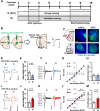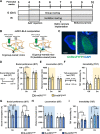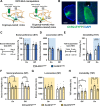Adolescent social isolation induces distinct changes in the medial and lateral OFC-BLA synapse and social and emotional alterations in adult mice
- PMID: 35697823
- PMCID: PMC9283446
- DOI: 10.1038/s41386-022-01358-6
Adolescent social isolation induces distinct changes in the medial and lateral OFC-BLA synapse and social and emotional alterations in adult mice
Abstract
Early-life social isolation is associated with social and emotional problems in adulthood. However, neural mechanisms underlying how social deprivation impairs social and emotional development are poorly understood. Recently, the orbitofrontal cortex (OFC) and basolateral amygdala (BLA) have been highlighted as key nodes for social and emotional functions. Hence, we hypothesize that early social deprivation disrupts the information processing in the OFC-BLA pathway and leads to social and emotional dysfunction. Here, we examined the effects of adolescent social isolation on the OFC-BLA synaptic transmission by optogenetic and whole-cell patch-clamp methods in adult mice. Adolescent social isolation decreased social preference and increased passive stress-coping behaviour in adulthood. Then, we examined excitatory synaptic transmissions to BLA from medial or lateral subregions of the OFC (mOFC or lOFC). Notably, adolescent social isolation decreased the AMPA/NMDA ratio in the mOFC-BLA synapse in adulthood, while the ratio was increased in the lOFC-BLA synapse. Furthermore, we optogenetically manipulated the mOFC-BLA or lOFC-BLA transmission in behaving mice and examined the effects on social and stress-coping behaviours. Optogenetic manipulation of the mOFC-BLA transmission altered social behaviour without affecting passive stress-coping behaviour, while optogenetic manipulation of the lOFC-BLA transmission altered passive stress-coping behaviour without affecting social behaviour. Our results suggest that adolescent social isolation induces distinct postsynaptic changes in the mOFC-BLA and lOFC-BLA synapses, and these changes may separately contribute to abnormalities in social and emotional development.
© 2022. The Author(s), under exclusive licence to American College of Neuropsychopharmacology.
Conflict of interest statement
The authors declare no competing interests.
Figures





Similar articles
-
Stress induces insertion of calcium-permeable AMPA receptors in the OFC-BLA synapse and modulates emotional behaviours in mice.Transl Psychiatry. 2020 May 18;10(1):154. doi: 10.1038/s41398-020-0837-3. Transl Psychiatry. 2020. PMID: 32424318 Free PMC article.
-
[The contribution of orbitofrontal cortex to stress-related psychiatric disorders: stress induced synaptic change in the orbitofrontal-basolateral amygdala pathway].Nihon Yakurigaku Zasshi. 2021;156(2):62-65. doi: 10.1254/fpj.20085. Nihon Yakurigaku Zasshi. 2021. PMID: 33642531 Japanese.
-
The Medial Orbitofrontal Cortex-Basolateral Amygdala Circuit Regulates the Influence of Reward Cues on Adaptive Behavior and Choice.J Neurosci. 2021 Aug 25;41(34):7267-7277. doi: 10.1523/JNEUROSCI.0901-21.2021. Epub 2021 Jul 16. J Neurosci. 2021. PMID: 34272313 Free PMC article.
-
Amygdala-cortical collaboration in reward learning and decision making.Elife. 2022 Sep 5;11:e80926. doi: 10.7554/eLife.80926. Elife. 2022. PMID: 36062909 Free PMC article. Review.
-
Cortico-Striatal-Thalamic Loop Circuits of the Orbitofrontal Cortex: Promising Therapeutic Targets in Psychiatric Illness.Front Syst Neurosci. 2017 Apr 27;11:25. doi: 10.3389/fnsys.2017.00025. eCollection 2017. Front Syst Neurosci. 2017. PMID: 28496402 Free PMC article. Review.
Cited by
-
Post-weaning social isolation alters sociability in a sex-specific manner.Front Behav Neurosci. 2024 Aug 29;18:1444596. doi: 10.3389/fnbeh.2024.1444596. eCollection 2024. Front Behav Neurosci. 2024. PMID: 39267986 Free PMC article.
-
Synaptic Density in Early Stages of Psychosis and Clinical High Risk.JAMA Psychiatry. 2025 Feb 1;82(2):171-180. doi: 10.1001/jamapsychiatry.2024.3608. JAMA Psychiatry. 2025. PMID: 39535765
-
Opioidergic tuning of social attachment: reciprocal relationship between social deprivation and opioid abuse.Front Neuroanat. 2025 Jan 23;18:1521016. doi: 10.3389/fnana.2024.1521016. eCollection 2024. Front Neuroanat. 2025. PMID: 39917739 Free PMC article. Review.
-
Development of the rodent prefrontal cortex: circuit formation, plasticity, and impacts of early life stress.Front Neural Circuits. 2025 Mar 26;19:1568610. doi: 10.3389/fncir.2025.1568610. eCollection 2025. Front Neural Circuits. 2025. PMID: 40206866 Free PMC article. Review.
-
Teleosts as behaviour test models for social stress.Front Behav Neurosci. 2023 Sep 7;17:1205175. doi: 10.3389/fnbeh.2023.1205175. eCollection 2023. Front Behav Neurosci. 2023. PMID: 37744951 Free PMC article. Review.
References
Publication types
MeSH terms
LinkOut - more resources
Full Text Sources

